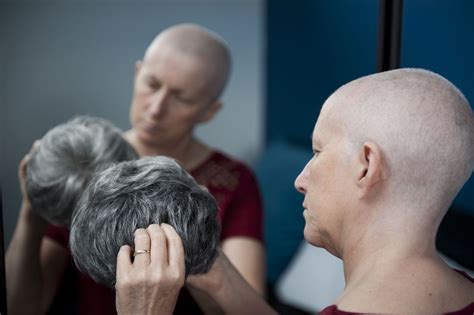Introduction
Cancer treatments can cause a range of side effects, including hair loss. For many patients, this can be a difficult and emotionally distressing experience. Wigs can provide a sense of normalcy and confidence during this challenging time.

Types of Wigs
There are two main types of wigs: synthetic and human hair.
- Synthetic wigs are made from artificial fibers. They are less expensive than human hair wigs and are available in a wide range of colors and styles. However, they can be less comfortable to wear and may not last as long as human hair wigs.
- Human hair wigs are made from real human hair. They are more expensive than synthetic wigs but are more comfortable to wear and can last longer. They can also be styled and colored like your own hair.
Choosing a Wig
When choosing a wig, there are a few things to consider:
- Cap size: The cap size is the measurement of the circumference of your head. It is important to choose a wig that fits snugly but not too tightly.
- Hair length and style: The hair length and style should complement your face shape and personal style.
- Color: The wig color should match your natural hair color or be a color that you think would look good on you.
- Material: The material of the wig will determine how comfortable it is to wear and how long it will last.
How to Care for a Wig
Wigs require special care to keep them looking their best. Here are a few tips:
- Wash your wig regularly: The frequency with which you need to wash your wig will depend on how often you wear it. However, it is generally recommended to wash it every 2-3 weeks.
- Use a gentle shampoo and conditioner: Use a shampoo and conditioner that is specifically designed for wigs. Avoid using harsh chemicals or detergents, as these can damage the hair.
- Air dry your wig: Do not put your wig in the dryer, as this can cause the hair to become frizzy and tangled. Instead, air dry it on a wig stand or towel.
- Store your wig properly: When you are not wearing your wig, store it in a cool, dry place. Avoid storing it in direct sunlight, as this can cause the hair to fade.
Benefits of Wigs
Wigs can provide a number of benefits for cancer patients, including:
- Improved self-esteem: A wig can help you feel more confident and attractive.
- Reduced stress: Losing your hair can be a stressful experience. A wig can help you to feel more in control and reduce your stress levels.
- Protection from the elements: A wig can protect your scalp from the sun, wind, and cold.
- Privacy: A wig can help you to keep your hair loss private.
Cost of Wigs
The cost of a wig will vary depending on the type of wig, the length and style of the hair, and the material. Synthetic wigs typically cost between $100 and $500. Human hair wigs can cost between $500 and $2,000.
Where to Get a Wig
There are a number of places where you can get a wig, including:
- Cancer centers: Many cancer centers offer wigs to patients who are experiencing hair loss.
- Wig shops: Wig shops specialize in selling wigs and can help you find the perfect wig for your needs.
- Online retailers: There are a number of online retailers that sell wigs. However, it is important to do your research before purchasing a wig online.
Conclusion
Wigs can provide a number of benefits for cancer patients, including improved self-esteem, reduced stress, protection from the elements, and privacy. If you are considering getting a wig, talk to your doctor or a wig specialist to learn more about the different types of wigs available and how to choose the right one for you.
